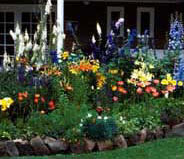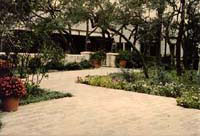In response to drought and limited water resources a number of new landscaping ideas have evolved to reduce water and maintenance requirements while still providing aesthetically pleasing landscapes. A philosophy for the conservation of water through creative landscaping has engendered the new term, xeriscape (pronounced “zera-scape”), The term xeriscape is derived from the Greek word XEROS meaning dry, combined with landscaping, thus xeriscaping. The term was coined in Colorado by the Denver Water Department in 1981.
 Native species are often preferred for natural landscapes but plant selection should take into consideration the microclimate and topography of the site. In some cases, native plants will not be the most appropriate choice because man’s development of a site can greatly alter the microclimate and topography. Thus, effective xeriscaping should match plants with the microclimatic features of the developed landscape site. Natural landscaping involves plant selection that is based on climate and environment of the area as well as site characteristics of exposure, light intensity, soil pH, soil aeration, soil mineral analysis, site drainage, and irrigation water quality. Proper plant selection based on site characteristics should enhance the plants’ likelihood of becoming established in the site and reduce potential incidences of low vigor, excessive maintenance, disease, or death.
Native species are often preferred for natural landscapes but plant selection should take into consideration the microclimate and topography of the site. In some cases, native plants will not be the most appropriate choice because man’s development of a site can greatly alter the microclimate and topography. Thus, effective xeriscaping should match plants with the microclimatic features of the developed landscape site. Natural landscaping involves plant selection that is based on climate and environment of the area as well as site characteristics of exposure, light intensity, soil pH, soil aeration, soil mineral analysis, site drainage, and irrigation water quality. Proper plant selection based on site characteristics should enhance the plants’ likelihood of becoming established in the site and reduce potential incidences of low vigor, excessive maintenance, disease, or death.
The importance of water conservation in Georgia has increased as water shortages; restrictions of its use and population growth have placed increasing strain on available water supplies. Landscape Efficiency is a more general term and perhaps better accounts for the conditions prevalent to Georgia. After all, Georgia is not a dry state and averages between 46 and 76 inches of rain on non-drought years. Let’s look at the following steps of Xeriscaping in more detail.
The Seven Principles of Xeriscape
1) Planning and Design
Start with an accurate plan of the site, identify site problems and potentials, and develop a list of needs and wants to be incorporated in the new plan. As your plan begins to take form, divide the landscape into water-use zones. Incorporate shade where possible, and develop your plan using appropriate plants. Consider renovation of your existing landscape. You will find that in the long term you will save water and money!
2) Soil Analysis
Before planting, check the structure and texture of the native soil. Your goal for soil analysis is to help you create an ideal soil environment for the expanding root system. An ideal soil has good aeration and drainage, yet holds adequate moisture and nutrients for optimum root growth.
3) Limited Turf Areas
Use turf for a function or aesthetic benefit, such as in a recreational area, to prevent erosion on a slope or as a welcome mat to the home. Select a turfgrass that is adapted to the site and has good drought resistance. Be willing to accept a less than perfect look. A healthy turfgrass will wilt and turn brown during periods of drought and spring back to its normal color and growth pattern with adequate water.
4) Appropriate Plant Selection
Some plants are perfect for adding year-round greenery and texture; others are great for adding seasonal color. Select plants appropriate to the site and the imposed stresses of the environment. Many of the Southern ornamental plants presently on the market are good candidates for a water-wise landscape as long as they are adapted to the site and zoned in the landscape according to their water need. For more information go to: http://pubs.caes.uga.edu/caespubs/pubcd/B1073.htm#Tables
5) Efficient Irrigation
By irrigating between midnight and 10am (state wide restriction preset days are: odd numbered addresses on Sundays, Tuesdays & Thursdays; even numbered addresses on Monday, Wednesday & Saturdays – NO WATERING on Fridays), less evaporation of water occurs. A well-planned and well maintained irrigation system can significantly reduce a traditional landscape’s water use. For the most efficient use of water, irrigate turf areas separately from other plantings. Other irrigation zones should be designed so low-water-use plants receive only the water they require. The use of a drip system may help with this goal.
6) Use of Mulches
Use fine-textured organic, non-matting mulches when possible. Fall leaves, pine straw, pine bark, mininuggets and shredded hardwood bark are excellent choices. Mulch as large an area as possible under trees and shrubs. The use of mulches helps conserve water in the soil and insulates the roots of plants from extreme heat in summer (cold in winter), cools the soil, reduces weed growth, minimizes evaporation and slows erosion. Mulches also reduce soil-borne foliar diseases by acting as a barrier between the soil and the foliage. Mulches can also provide landscape interest and offer protective cover until plants mature. Fine-textured mulches hold moisture in the soil better than coarse-textured mulches like large-nugget pine bark.
7) Proper Maintenance
Keep plants healthy, but do not encourage water-demanding new growth. Once plants are established, reduce the amount of nitrogen applied as well as the application rate and frequency of application. Avoid plant stress by mowing properly, by thinning shrubs instead of shearing, and by controlling weeds and pests before they affect plant health.
 The goal of xeriscaping is to create a visually attractive landscape that uses plants selected for their water efficiency. A xeriscape-type landscape is low maintenance, saving you time, effort and money. It is also an environmentally sound landscape, requiring less fertilizer and fewer chemicals. Each of the above seven steps is a good gardening practice and the more of them you implement, the more water efficient your landscape becomes.
The goal of xeriscaping is to create a visually attractive landscape that uses plants selected for their water efficiency. A xeriscape-type landscape is low maintenance, saving you time, effort and money. It is also an environmentally sound landscape, requiring less fertilizer and fewer chemicals. Each of the above seven steps is a good gardening practice and the more of them you implement, the more water efficient your landscape becomes.
Properly maintained, a xeriscaped yard can easily save you money and reduce your water usage between 40-60 percent compared to a traditional landscape. According to a 1999 UGA drought statistic; for each 1000 square feet of landscape you no longer irrigated, you could save as much as $200 per year on your water and sewage bill. Nationally, communities have been faced with increased demands on existing water
supplies. Consequently, there is a greater focus on water conservation, not just in times of drought, but also in anticipation of future population growth. Water can no longer be considered a limitless resource.
